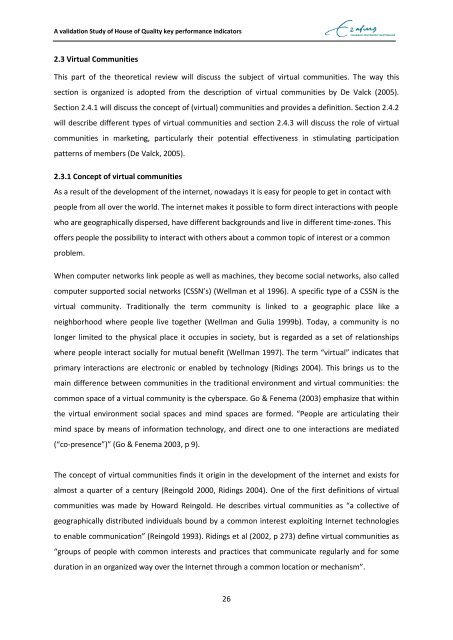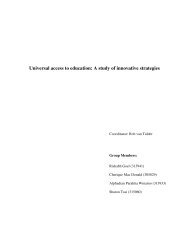here - ERIM - Erasmus Universiteit Rotterdam
here - ERIM - Erasmus Universiteit Rotterdam
here - ERIM - Erasmus Universiteit Rotterdam
Create successful ePaper yourself
Turn your PDF publications into a flip-book with our unique Google optimized e-Paper software.
A validation Study of House of Quality key performance indicators<br />
2.3 Virtual Communities<br />
This part of the theoretical review will discuss the subject of virtual communities. The way this<br />
section is organized is adopted from the description of virtual communities by De Valck (2005).<br />
Section 2.4.1 will discuss the concept of (virtual) communities and provides a definition. Section 2.4.2<br />
will describe different types of virtual communities and section 2.4.3 will discuss the role of virtual<br />
communities in marketing, particularly their potential effectiveness in stimulating participation<br />
patterns of members (De Valck, 2005).<br />
2.3.1 Concept of virtual communities<br />
As a result of the development of the internet, nowadays it is easy for people to get in contact with<br />
people from all over the world. The internet makes it possible to form direct interactions with people<br />
who are geographically dispersed, have different backgrounds and live in different time-zones. This<br />
offers people the possibility to interact with others about a common topic of interest or a common<br />
problem.<br />
When computer networks link people as well as machines, they become social networks, also called<br />
computer supported social networks (CSSN’s) (Wellman et al 1996). A specific type of a CSSN is the<br />
virtual community. Traditionally the term community is linked to a geographic place like a<br />
neighborhood w<strong>here</strong> people live together (Wellman and Gulia 1999b). Today, a community is no<br />
longer limited to the physical place it occupies in society, but is regarded as a set of relationships<br />
w<strong>here</strong> people interact socially for mutual benefit (Wellman 1997). The term “virtual” indicates that<br />
primary interactions are electronic or enabled by technology (Ridings 2004). This brings us to the<br />
main difference between communities in the traditional environment and virtual communities: the<br />
common space of a virtual community is the cyberspace. Go & Fenema (2003) emphasize that within<br />
the virtual environment social spaces and mind spaces are formed. “People are articulating their<br />
mind space by means of information technology, and direct one to one interactions are mediated<br />
(“co-presence”)” (Go & Fenema 2003, p 9).<br />
The concept of virtual communities finds it origin in the development of the internet and exists for<br />
almost a quarter of a century (Reingold 2000, Ridings 2004). One of the first definitions of virtual<br />
communities was made by Howard Reingold. He describes virtual communities as “a collective of<br />
geographically distributed individuals bound by a common interest exploiting Internet technologies<br />
to enable communication” (Reingold 1993). Ridings et al (2002, p 273) define virtual communities as<br />
“groups of people with common interests and practices that communicate regularly and for some<br />
duration in an organized way over the Internet through a common location or mechanism”.<br />
26
















